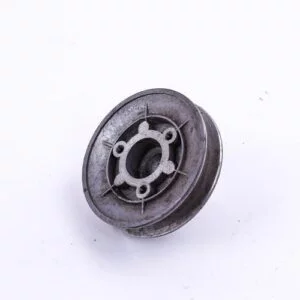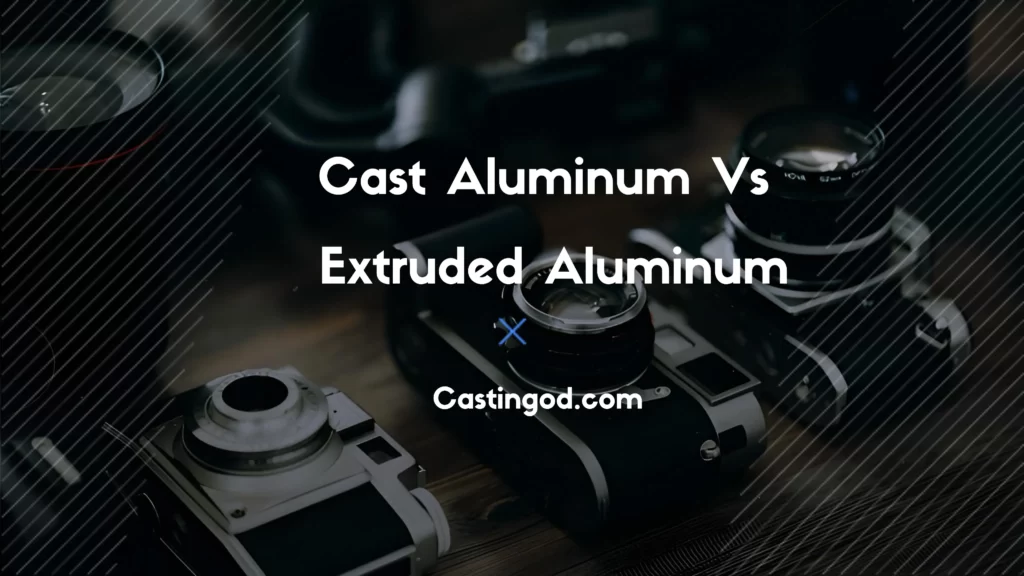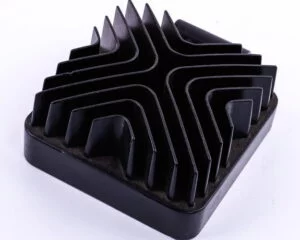Extrusion and casting are two of the many industrial processes that can be used with aluminum. You often wonder, “What is the difference between aluminum extrusion and casting?” Extrusion is a process that uses pressure to push aluminum billets into a die and produce a perfect cross-section. However, casting involves pouring molten aluminum into a mold and allowing it to cool before it solidifies.
Both techniques are affordable because they provide a precise net shape and shorten the machining process.
We must first define each method in order to compare them.
Cast Aluminum
What Is Cast Aluminum?
Cast aluminum is a method of making an aluminum component using one of the various casting methods. Typically, molten aluminum is heated and poured into a mold that has been prepared with the intended product design during the majority of aluminum casting operations. The aluminum then cools, hardens, and adopts the shape of the cavity.

The aluminum cast possesses the qualities of both aluminum and other metals. Additionally, it becomes stronger than regular aluminum because of the exterior coating of aluminum oxide that forms.
Process of Casting Aluminum
There are three primary metal casting processes that are compatible with aluminum. The processes and their unique characteristics are listed below.
Die Casting
Die casting is the most widely used aluminum casting method for producing aluminum parts. There are two methods: low-pressure die casting and high-pressure die casting, which is more appropriate for the material.
Die casting entails quickly injecting heated aluminum into a die mold that has been made for the finished item. The cycle is then repeated when the die has cooled and the cast aluminum item is removed from the die.
Sand Casting Aluminum
You may already be aware that one of the most well-liked and traditional processes for casting aluminum is sand casting. It is used to make a mold out of sand and blinkers by pushing a template tightly into the sand, resulting in a hollow mold chamber.
An effective gating system is used to properly flow the molten aluminum into the mold cavity, where it may solidify and take on the desired shape.
Permanent Mold Casting
Die casting and permanent mold casting are similar. However, the method used to inject the aluminum into the mold differs between the two methods. Permanent mold casting differs from die casting in that the mold is filled using gravity rather than high or low pressure. As a result, it causes less turbulence when injecting.
This method produces stronger aluminum casts with excellent surface polish and close dimensional precision. The method can be used to create aluminum components for the automotive and aerospace industries.
What Qualities Does Cast Aluminum Possess?
In casting, aluminum is typically used in its alloys instead of as pure aluminum. Which has the following characteristics:
- Aluminum alloys have a higher ductility than pure aluminum metal, which is quite soft.
- The procedure has a significant impact on ultimate tensile strength (UTS).
- Gas inclusions and cavities, which can be common in simpler methods, significantly damage castings with higher porosity.
- Aluminum castings offer an extraordinary stiffness-to-weight ratio. Porosity is a persistent issue with low-pressure aluminum casting.
- Cast aluminum parts typically have excellent corrosion resistance.
- Outstanding thermal and electrical conductivity.
What Are the Characteristics of Cast Aluminum?
The following are a few examples of different applications of cast aluminum:
- Automotive components: steering knuckles, pistons, and gearbox housings
- Homewares and small appliances: lawnmowers, cookware, patio furniture, and hand tools
- Medical equipment: surgical instruments, monitor parts, and gearboxes for hospital beds
How Durable Is Cast Aluminum?
Aluminum die-cast parts can be anticipated to last forever under ideal conditions. Die-cast aluminum auto parts, for example, can continue working after 50+ years of use.
What Are the Advantages of Aluminum Casting?
The advantages of aluminum die casting include:
- A high strength-to-weight ratio.
- Great strength.
- Lightweight.
- Resilience to fluctuating and cyclic loads.
- High accuracy.
- Simple machining.
- Automated and high-volume production.
- Minimal corrosion, especially in marine settings.
What Is the Most Effective Way to Clean Cast Aluminum?
Cleaning cast aluminum can be difficult. It is susceptible to stains and discoloration, making it difficult to remove without employing abrasive treatments. Now, you can easily clean your cast aluminum without using chemicals by following a few steps.
Using baking soda for cleaning
Cast aluminum can be easily cleaned with baking soda because it is non-toxic and kind to the metal’s surface. A cup of baking soda and warm water can be used to create a cleaner in a spray bottle. After ten minutes, you can wipe the solution off with a moist cloth or sponge.
Using Vinegar
Another natural cleanser that is risk-free to use on surfaces made of cast aluminum is vinegar. In a bowl or spray bottle, mix one-part white vinegar with three parts warm water to make vinegar for cleaning. Apply the mixture, wait fifteen minutes, and then scrub the metal with a wet cloth.
Cast aluminum Polishing
Once your cast aluminum has been well cleaned, you can choose to polish it with lemon or olive oil to give it an extra sheen. Apply olive oil to the metal surface, and remove any excess oil with a towel for shining.
Cast Aluminum and Other Common Manufacturing Processes
Aluminum casting has multiple advantages over other methods of manufacturing, like gravity die casting. Some of its significant advantages are as follows:
- Rapid rate of production.
- For people who require small-scale production, it is a good option due to its relative affordability.
- It can be used to create the most intricate shapes.
- Aluminum is perfect for making components for automotive and aerospace industries.
Extruded Aluminum
What is Extruded Aluminum?
Extruding aluminum involves pressing aluminum alloy material into a die with a cross-sectional form. The aluminum is pushed through the die and out of the hole by a powerful ram. When this occurs, it emerges in the precise shape of the die and is carried away along a runout table.
Characteristics of Extruded Aluminum
The Aluminum Extruders Council lists several advantages of extruded aluminum, some of which are as follows:
Light weight: Aluminum extrusions are an appealing, economical material to utilize in applications where less weight is desired since they are substantially lighter than other metals and are easy to handle and carry.
Strength and malleability: Aluminum extrusions can be made more pliable and stronger by altering the profile’s wall thicknesses and structural reinforcing. Aluminum actually gets stronger in colder temperatures, making it ideal for outdoor applications or items that will be exposed to the elements.
Corrosion resistance: Aluminum extrusions are not susceptible to rusting, and a naturally formed oxide film protects their surface.
Excellent thermal conductivity: Aluminum extrusion is the best option for applications needing heat exchangers or heat dissipation since it transmits heat and cold better than other popular metals.
The Process of Aluminum Extrusion
Following are the steps involved in the aluminum extrusion process:
- After designing and producing the die’s shape, an aluminum alloy billet is heated to a temperature between 800°F and 925°F.
- The aluminum billet is next moved to a loader, where the lubricant is supplied to prevent it from following the extrusion machine, the ram, or the handle.
- A ram applies significant pressure to a mock block, driving the aluminum billet into the container and into the die.
- Nitrogen is supplied and allowed to circulate through the die’s sections in order to prevent the production of oxides. This extends the die’s life and produces an inert environment.
- The extruded part is transferred to a run-out table in the form of an extended piece that resembles the die opening. The newly produced aluminum extrusion is then carried to the cooling table, where fans are used to cool it.
- The extruded aluminum is transferred to a stretcher for leveling and hardening when cooling is complete.
- On the saw table, the hardened extrusions are cut to the necessary lengths.
- The extrusions are heated in aging ovens as the last stage, which hardens the aluminum by accelerating the aging process.
Applications of Aluminum Extrusion
There are many applications in which Aluminum extrusions have been used. Such as:
Construction Sector: In the construction industry, aluminum extrusions are frequently used to make curtain walls, doors, structural framing, and windows. They provide a strong, lightweight substitute for conventional construction supplies like wood and steel.
Automotive Sector: The automotive sector uses aluminum extrusions to create components including body panels, engine blocks, and heat exchangers. They have qualities like strong strength and light weight that increase fuel economy and lower pollutants.
Aerospace Sector: Aluminum extrusions are widely used in airplane manufacturing to make parts including landing gear, fuselage frames, and wing structures. They have strong corrosion resistance and a high strength-to-weight ratio, both of which are necessary for aircraft parts.
Comparison with Cast Aluminum

The difference between extruded and cast aluminum is not limited to the manufacturing process. Some main differences are given in the table below:
| Key Points | Cast Aluminum | Extruded Aluminum |
| Product Size | Ingot’s size does not affect the size of the finished products. | The size is restricted to the dimensions of the billet. |
| Product’s Shape | The forms of cast aluminum goods are more intricate than those of extruded aluminum. | Extruded aluminum products are easier to use. |
| Surface Finish | After casting, products have an imperfect surface finish. | After extrusion, products have a better surface finish. |
| Strength of Part | Products are less strong than extruded aluminum and are more prone to flaws. | Extruded aluminum products have a great life span with fewer flaws. |
| Die Properties | Extrusion dies last longer and are more expensive than casting dies. | Extrusion dies are more affordable and durable. |
| Cost of Production | Large-volume production is less expensive than short-volume manufacturing. | Large-volume production is more expensive than short-volume manufacturing. |
| Time of Production | Creates a portion more slowly than extrusion. | Produces a part faster than casting does. |
Conclusion
Extrusion and die casting are both excellent methods for creating aluminum items.
Die castings are typically more expensive up front, but depending on the components being produced, you may be able to cut expenses on post-casting machining and assembly. Extrusions may have limited shape options and necessitate more post-forming machining and assembly. They cost less to create and are typically stronger.
Your final decision will be based on the particulars of your project since each processing method will result in a distinct set of mechanical qualities and production costs.









